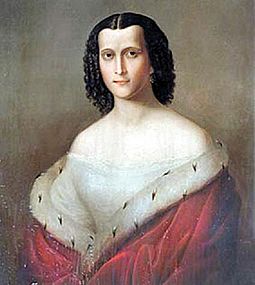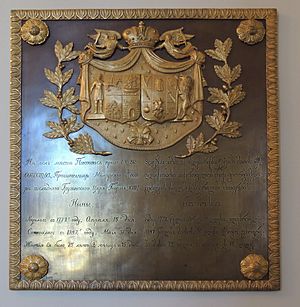Nino, Princess of Mingrelia facts for kids
Quick facts for kids Nino |
|
|---|---|
 |
|
| Princess of Mingrelia | |
| Tenure | 1791/94–1802 1802–1804 |
| Born | 15 April 1772 Tiflis, Kingdom of Kartli-Kakheti |
| Died | 30 May 1847 Saint Petersburg, Russian Empire |
| Burial | Church of St. John Chrysostom, Alexander Nevsky Lavra |
| Spouse | Grigol Dadiani, Prince of Mingrelia |
| Issue among others... |
Levan V Dadiani, Prince of Mingrelia |
| Dynasty | Bagrationi dynasty |
| Father | George XII of Georgia |
| Mother | Ketevan Andronikashvili |
| Religion | Georgian Orthodox Church |
Nino (Georgian: ნინო; 15 April 1772 – 30 May 1847) was a Georgian princess. She was the daughter of King George XII of Georgia. She also became the princess of Mingrelia by marrying Grigol Dadiani, the ruler of Mingrelia.
After her husband died in 1804, Princess Nino became a regent for her young son, Levan. This meant she ruled Mingrelia until he was old enough. She played a big part in bringing Mingrelia and the nearby Abkhazia under the control of the Russian Empire. In 1811, she moved to Saint Petersburg, Russia, where she lived until she passed away at 75 years old.
Contents
Early Life of Princess Nino
Princess Nino was born in Tbilisi in 1772. She was the sixth child of Crown Prince George and his first wife, Ketevan Andronikashvili. Her grandfather, Heraclius II of Georgia, was still king when she was born.
In 1791, when Nino was 19, she married Grigol Dadiani, the Prince of Mingrelia. Around the same time, Grigol's sister Mariam married Nino's cousin, King Solomon II of Imereti. These marriages were planned to create a strong alliance between the Georgian rulers. This alliance was formed in 1790 by King Heraclius II's minister, Solomon Lionidze.
However, the friendship between Solomon and Grigol soon turned sour. They argued over land. Between 1791 and 1802, Grigol lost his throne three times because of Solomon's influence. Grigol and Nino then sought help from the Russian Empire. Russia had taken over Nino's father's kingdom in 1801 and was interested in Imereti. By a treaty on December 1, 1803, Mingrelia became an independent part of the Russian Empire. To celebrate this, Princess Nino received special gifts from the Russian Empress, including a sable fur coat and a long piece of crimson velvet.
Princess Nino's Regency
When Prince Grigol Dadiani suddenly died on October 23, 1804, Princess Nino became very involved in Mingrelia's politics. She believed rival nobles had poisoned her husband. She asked the Russian commander in Georgia, Prince Pavel Tsitsianov, to investigate.
On November 3, 1804, the Russian government officially recognized her as the ruler of Mingrelia. They confirmed she would be regent until her 12-year-old son Levan turned 20. Levan had been held by Kelesh Ahmed-Bey Shervashidze, the Prince of Abkhazia, since 1802. He was a hostage in exchange for help in Grigol's power struggles. In March 1805, Russian troops entered Abkhazia. They returned the fort of Anaklia to Mingrelia and rescued Levan.
A council helped Princess Nino rule Mingrelia. This council included important figures like Prince Niko Dadiani and Bishop Besarion of Chkondidi. Princess Nino's relationships with some council members were difficult. Some people accused her of using the council for her own goals. These power struggles continued throughout her time as regent.
Princess Nino continued her husband's policy of supporting Russia. During the Russo-Turkish war (1806–1812), she led Mingrelian troops. They joined the Russians in capturing the Black Sea fortress of Poti from the Ottoman forces in 1809. In 1810, Nino sent 1,000 soldiers to help her ally, Sefer Ali-Bey Shervashidze of Abkhazia. He removed his brother, Prince Aslan-Bey, who supported the Ottomans. This brought Abkhazia under Russian protection.
Life in Russia
In 1811, Princess Nino's role in governing Mingrelia changed. She was called to St. Petersburg, Russia. There, she was given an important position as a statsdame (a lady-in-waiting to the Empress). She also received a high honor, the Grand Cross of the Order of St. Catherine. Her younger son, Giorgi, and the Abkhazian heir, Dimitri, went with her to the capital. They joined the Cadet Corps for military training.
In early 1820, while Nino was on vacation, her son Giorgi was suspected of helping rebels. His older brother, Levan, was fighting these rebels with the Russian army. Princess Nino was escorted to Ryazan, but she was later allowed to return to St. Petersburg. She spent the rest of her life there and passed away on May 31, 1847. She was buried at the Church of St. John Chrysostom, within the Alexander Nevsky Lavra.
The only known portrait of Princess Nino was painted when she lived in St. Petersburg. In 2010, an Australian businessman named Victor Greenwich Dadianov bought it. He is a descendant of the Dadiani family. He gave the portrait to the Dadiani Palaces Museum in Zugdidi, Georgia.
Princess Nino's Children
Prince Grigol and Princess Nino had six children: two sons and four daughters.
- Princess Ketevan (born 1792): She first married Manuchar Shervashidze, Prince of Samurzakano. Later, in 1823, she married Rostom-Bey, son of Kelesh Ahmed-Bey Shervashidze, Prince of Abkhazia.
- Prince Levan (1793–1846): He became the Sovereign Prince of Mingrelia from 1804 to 1840.
- Princess Mariam (born 1794): She first married Prince Giorgi Eristavi of Guria. Around 1810, she married Prince Rostom (Tato), son of Beri Gelovani.
- Princess Elene (born 1795): She first married Prince David Gurieli. Later, she married Prince Giorgi Mikeladze.
- Princess Ekaterine (born 1797): In 1810, she married Colonel Prince Beglar (Petre) Jambakur-Orbeliani.
- Prince Giorgi (1798–c. 1851): He became a Major-General in the Russian army. He married Countess Elizaveta Pahlena in 1839 but had no children.
See also
 In Spanish: Ninó de Mingrelia para niños
In Spanish: Ninó de Mingrelia para niños


